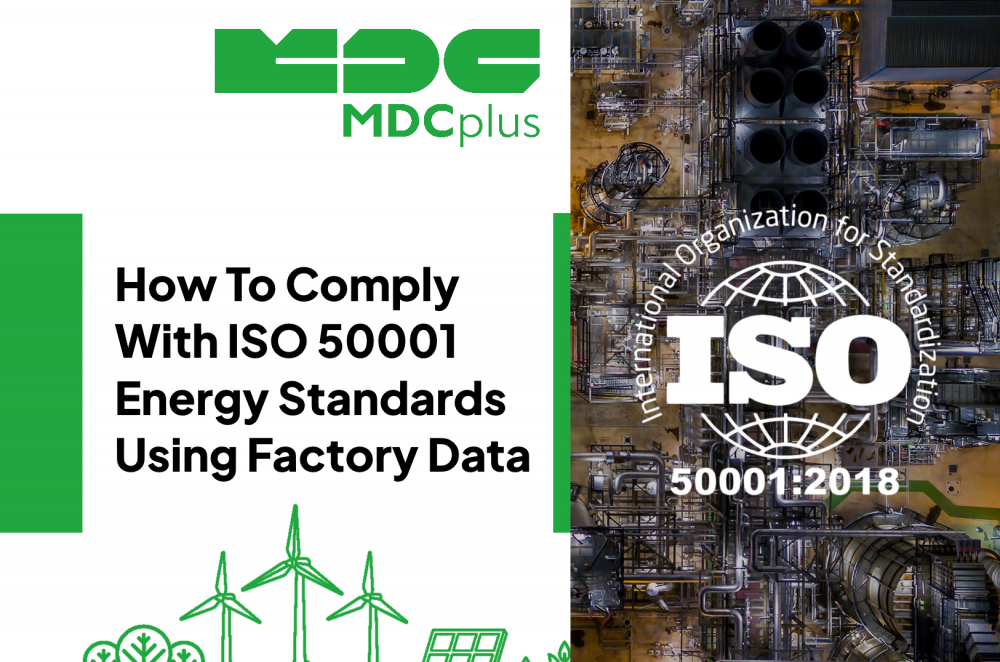How To Comply With ISO 50001 Energy Standards Using Factory Data
The global standard ISO 50001 gives manufacturers a blueprint for systematic energy management. But the strongest factories go further: they feed live machine and process data into their energy systems to track KPIs like energy-per-part and idle energy loss.
What ISO 50001 Actually Requires
ISO 50001 is an energy-management system (EnMS) standard designed to help organisations improve energy use, set targets, measure results and continually optimise. For manufacturing operations this matters because energy often represents 10-20% or more of production cost. Key requirements include:
- Establishing an energy policy and significant energy uses (SEUs)
- Defining energy performance indicators (EnPIs)metrics tracking energy relative to business output
- Measuring baseline energy performance, implementing action plans, and reviewing results via PDCA (Plan-Do-Check-Act).
Why Digital Monitoring is the Missing Link
Many factories attempt ISO 50001 implementation with monthly energy bills and high-level audits. But to fully exploit the standard’s potential you need machine-level visibility: monitoring individual equipment, shifts and process flows in real time. Digital monitoring systems (IIoT sensors, machine data collection platforms) bring this into reality by:
- Capturing actual machine runtime, cycle counts and idle states
- Linking that with energy-meter data to compute metrics like kWh per part or kWh per hour of active production
- Supporting automation of data import, dashboards and KPI tracking — turning energy management into operational performance management, not just compliance.
Which Energy KPIs Matter in Manufacturing
To bridge ISO 50001 with machine monitoring you must pick the right metrics. Key KPIs include:
- Energy Consumption per Unit of Production (e.g., kWh per part or kWh per ton) — a clear EnPI.
- Idle Energy or Standby Consumption — energy used when machines are idle but still powered.
- Peak Demand and Load Factor — tracking maximum vs average energy draw, reducing cost of peak charges.
- Energy Cost per Unit Output — translating energy use into direct cost per product.
Each of these becomes actionable when machine-monitoring data provides the “unit output” and runtime information needed to calculate them.
How to Use Monitoring Data to Comply With ISO 50001
Here’s a practical workflow for aligning ISO 50001 with factory monitoring:
- Baseline: Identify your SEUs — which machines, lines or processes consume the most energy. Use machine monitoring to capture runtime, cycle count and idle time.
- Data Integration: Connect machine-monitoring system with energy-meter or building-energy data. Link production counts to runtime and energy use.
- Define EnPIs: Choose meaningful metrics (for example: kWh/part). Set a target such as “reduce kWh/part by 10% in 12 months”.
- Identify Waste: Use the monitoring system to spot machines running idle, unexpected mode changes, or inefficient cycles.
- Track and Review: Monitor your selected KPIs regularly, report monthly to management, revise targets via the Check-Act step of ISO 50001.
- By making machine data part of your energy management system, you provide proof of improvement — not just intentions.
Overcoming Common Challenges
- Data quality & alignment: Ensure that machine-monitoring data (runtime, parts produced) and energy data (meters) align correctly in time and scope.
- Granularity vs overload: Too many data points can overwhelm; focus initially on top-consuming equipment and key KPIs.
- Workforce engagement: Operators and maintenance need to trust the system — ensure transparency and simple dashboards.
- Integration effort: Aligning machine-monitoring tools with energy management systems and MES/ERP can require planning and stakeholder buy-in.
- Change management: Energy management shifts from being “someone’s job” to everyone’s job — success depends on culture as much as data.
The Business Case: Why This Matters
Implementing ISO 50001 via machine monitoring makes business sense, not just environmental sense.
- Facilities have reported energy performance improvements of 5-30% within a few years of ISO 50001 adoption.
- Low-cost operational measures delivered paybacks often in under 18 months.
- Linking energy KPIs to production output means each kWh saved directly improves margin.
In short: energy monitoring isn’t a side initiative—it’s a lever for cost reduction, sustainability, and competitive advantage.
Quick-Start Checklist
To get moving quickly:
- Appoint an Energy & Monitoring Lead.
- Identify your top 3 SEUs by energy consumption.
- Connect machine-monitoring system to those lines and capture runtime + production count.
- Define KPIs: kWh/part, idle kWh per facility hour.
- Build live dashboard and review monthly.
- Expand to other lines once initial gains are visible.
ISO 50001 provides the framework; machine-level monitoring delivers the data. When “parts produced” meets “kWh consumed”, energy management becomes operational performance management. For manufacturers asking “how do we justify monitoring for energy?” the answer is: by proving it delivers measurable results. Turn energy from a cost into an advantage — and make your factory standards-ready, smart and profitable.
About MDCplus
Our key features are real-time machine monitoring for swift issue resolution, power consumption tracking to promote sustainability, computerized maintenance management to reduce downtime, and vibration diagnostics for predictive maintenance. MDCplus's solutions are tailored for diverse industries, including aerospace, automotive, precision machining, and heavy industry. By delivering actionable insights and fostering seamless integration, we empower manufacturers to boost Overall Equipment Effectiveness (OEE), reduce operational costs, and achieve sustainable growth along with future planning.
Ready to increase your OEE, get clearer vision of your shop floor, and predict sustainably?
